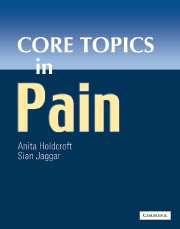Book contents
- Frontmatter
- Contents
- Contributors
- Preface
- Acknowledgements
- Foreword
- General abbreviations
- Basic science abbreviations
- PART 1 BASIC SCIENCE
- PART 2 PAIN ASSESSMENT
- Section 2a Pain measurement
- Section 2b Diagnostic strategies
- PART 3 PAIN IN THE CLINICAL SETTING
- Section 3a Clinical presentations
- 14 Epidemiology of pain
- 15 Pain progression
- 16 Analgesia in the intensive care unit
- 17 The chronic pain patient
- 18 Post-operative pain management in day case surgery
- Section 3b Pain syndromes
- PART 4 THE ROLE OF EVIDENCE IN PAIN MANAGEMENT
- PART 5 TREATMENT OF PAIN
- Section 5a General Principles
- Section 5b Physical treatments
- Section 5c Pharmacology
- Section 5d Psychosocial
- PART 6 SUMMARIES
- Glossary
- Index
15 - Pain progression
from Section 3a - Clinical presentations
Published online by Cambridge University Press: 10 December 2009
- Frontmatter
- Contents
- Contributors
- Preface
- Acknowledgements
- Foreword
- General abbreviations
- Basic science abbreviations
- PART 1 BASIC SCIENCE
- PART 2 PAIN ASSESSMENT
- Section 2a Pain measurement
- Section 2b Diagnostic strategies
- PART 3 PAIN IN THE CLINICAL SETTING
- Section 3a Clinical presentations
- 14 Epidemiology of pain
- 15 Pain progression
- 16 Analgesia in the intensive care unit
- 17 The chronic pain patient
- 18 Post-operative pain management in day case surgery
- Section 3b Pain syndromes
- PART 4 THE ROLE OF EVIDENCE IN PAIN MANAGEMENT
- PART 5 TREATMENT OF PAIN
- Section 5a General Principles
- Section 5b Physical treatments
- Section 5c Pharmacology
- Section 5d Psychosocial
- PART 6 SUMMARIES
- Glossary
- Index
Summary
Epidemiological studies
Epidemiological studies have shown wide variation in their estimates of chronic pain in the community ranging from 7% to 54%. Most of these studies are cross sectional; that is, they provide information at only one point of time. However, a recent longitudinal study reported pain prevalence in the same community over a 4-year period. There was no significant difference in pain reports between men and women at baseline. The proportion of the population reporting chronic pain significantly increased with age. The overall prevalence of pain increased from 45.5% of the population at baseline to 53.8% at follow-up; that is, an increase of 8.3% over the 4 years. There was a larger increase in prevalence among women than men and the increase was highest in the youngest age group (25–34 years). Of those who had pain at baseline, the pain persisted in 78.5% and resolved in 21.5%. Health factors (as measured by the SF-36) appeared to be better predictors of chronic pain rather than measured socio—demographic factors (such as level of education, marital status, housing or employment status). Individuals who were in the lowest quartile of SF-36 domains — physical functioning, social functioning and bodily pain at baseline — were more likely to develop chronic pain at follow-up and less likely to recover from chronic pain.
- Type
- Chapter
- Information
- Core Topics in Pain , pp. 103 - 108Publisher: Cambridge University PressPrint publication year: 2005
- 1
- Cited by



